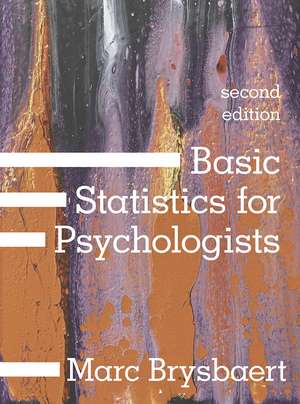Basic Statistics for Psychologists
Autor Marc Brysbaerten Limba Engleză Paperback – 29 oct 2019
Preț: 315.32 lei
Preț vechi: 358.53 lei
-12% Nou
Puncte Express: 473
Preț estimativ în valută:
60.34€ • 64.52$ • 50.31£
60.34€ • 64.52$ • 50.31£
Carte disponibilă
Livrare economică 28 martie-11 aprilie
Livrare express 13-19 martie pentru 110.24 lei
Preluare comenzi: 021 569.72.76
Specificații
ISBN-13: 9781137607461
ISBN-10: 1137607467
Pagini: 560
Ilustrații: 15 bw illus
Dimensiuni: 193 x 260 x 31 mm
Greutate: 1.18 kg
Ediția:2nd ed. 2020
Editura: Bloomsbury Publishing
Colecția Red Globe Press
Locul publicării:London, United Kingdom
ISBN-10: 1137607467
Pagini: 560
Ilustrații: 15 bw illus
Dimensiuni: 193 x 260 x 31 mm
Greutate: 1.18 kg
Ediția:2nd ed. 2020
Editura: Bloomsbury Publishing
Colecția Red Globe Press
Locul publicării:London, United Kingdom
Caracteristici
Coverage of the key methods of statistical inference, and how to interpret the results of various statistical tests
Notă biografică
MARC BRYSBAERT is currently Research Professor of Psychology at Ghent University, Belgium. Previously he was Professor of Psychology at Royal Holloway, University of London, where he taught both statistics and research methods. Marc has extensive publishing experience and has written the market-leading book on 'Conceptual and Historical Issues in Psychology', published by Pearson, as well as a Dutch Handbook of Psychology, and more.
Cuprins
1. Using statistics in psychology research 2. Summarising data using the frequency distribution 3. Summarising data using measures of central tendency 4. Summarising data using measures of variability 5. Standardised scores, normal distribution and probability 6. Using the t-test to measure the difference between independent groups 7. Interpreting the results of a statistical test: The traditional approach 8. Interpreting the results of a statistical test: The Bayesian approach 9. Non-parametric tests of difference between independent groups 10. Using the t-test to measure change in related samples 11. Non-parametric tests to measure changes in related samples 12. Improving predictions through the Pearson correlation coefficient 13. Improving predictions through non-parametric tests 14. Using analysis of variance as an extension of t-tests 15. Using analysis of variance for designs with more than one independent variable 16. More than one predictor in correlational studies: Multiple regression 17. More than one observation per condition per participant: Mixed-effects analysis.
